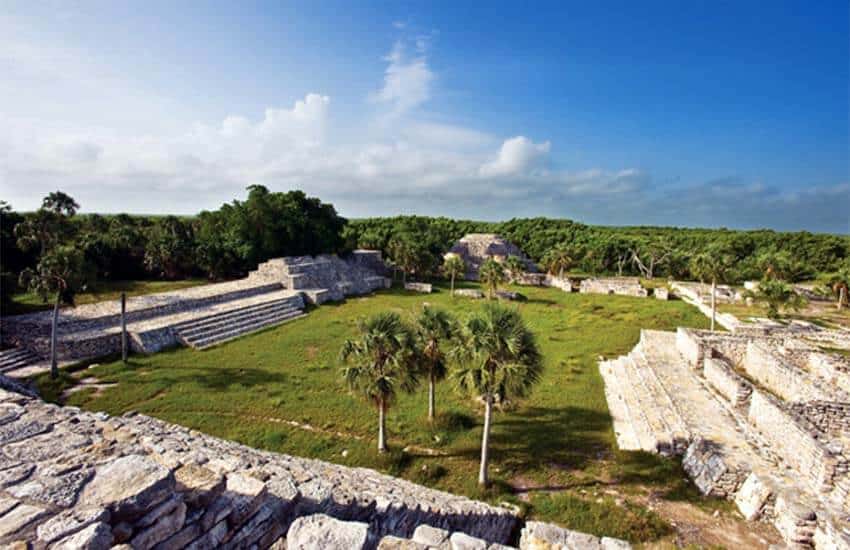While many interested in the ancient Maya know about their complex religious life, their mathematical, scientific and architectural advances and their hierarchical social structures, perhaps a lesser-known side of these indigenous people is their capitalist side.
Those interested in a wider understanding of Maya prehistory might consider visiting the north coast of Yucatán, where one can easily access the ruins of Xcambó, an ancient port city situated off coastal highway 27, between Progreso and Telchac Puerto, Yucatán. The city is notable as an administrative center for the prehistoric Mayan salt trade during the Classic Period (A.D. 250–900)
The site, whose name is Mayan for “celestial crocodile” as well as “place of exchange” or “place where bartering takes place,” is less than an hour’s drive from Mérida.
Xcambó is smaller than other more famous Maya sites of Yucatán, but it has some interesting structures to explore. And since few tourists visit there, it’s a relaxing trip.
Near Xcambó are the Xtampú salt flats, which are still operational and whose water is sometimes bright pink, hence its name, the Pink Lagoon. You can also watch flamingos there. According to the National Institute of Anthropology and History (INAH), Xcambó’s main economic activity was salt production and Xcambó was the administrative center for the salt flats located on the north coast and to the northwest. The city’s occupation and its salt production are thought to date as far back as 100 B.C.

However, INAH says Xcambó was built as a commercial port around A.D. 350–550 and was the largest trading port on Yucatan’s northern coast in the Classic Period. The site is thought to have been abandoned around the late Classic Period. Following its abandonment, the site was used as a religious place during the Postclassic period (A.D. 900–1500), according to INAH.
The site had white raised roads thought to have connected it to other Maya sites. There is also an internal white road. INAH says that more than 600 burial sites, as well as hundreds of vessels, were discovered here. Areas that may have been for salt storage were also found.
Xcambó was built on a Petén — an area encircled by a wetland. Therefore, the natural surroundings, including the mangroves, make exploring the ancient city a pleasant experience, and a visit can be accomplished within a couple of hours at most.
There are three groups of buildings. Architecture fans can observe multiple building design styles here. The most notable section is the central plaza, which features 11 structures. Civic, administrative and religious activities took place there.
North of the plaza is a seven-level pyramid with a central stairway called the Temple of the Cross. A wooden cross was erected atop of this building, although on our last visit, we found that it had fallen. You can climb this pyramid for a beautiful view of the site.
In front of the Pyramid of the Cross structure is one of the small well-like water springs of the site. Next to the pyramid is the Temple of the Sacrifices with its two tiny, vaulted temples.
A must-see in the central plaza, however, is the Pyramid of the Masks, located to the south. On the third level are two stucco masks placed on either side of the central stairway. The masks’ placement indicates the path and direction taken by the planet Venus, which was thought to lead the sun from the underworld at sunrise and to accompany it at sunset, according to INAH.
An interesting structure located next to the Pyramid of the Masks is a building called the Steam Bath, which seems to be an ancient version of a steam room or spa. It features a place where the water was boiled. It was used by the city’s elite.
A tunnel-like structure to the west of the central plaza is interesting in that despite its appearance, the passage is closed at the end and does not lead anywhere.
Behind this structure is a small chapel called the Temple of the Virgin, showing the later influence of Catholicism on Xcambó. A newer addition to the site, it was built in the last century.
Inside, the church has an altar. The faithful believe a virgin appeared in Xcambó, and the chapel is visited for worship even today.
Other structures to see include residential buildings and stone tools that look like metates, perhaps used for grinding, including making salt into powder. The east plaza that you will pass after leaving the main site is also worth looking at.

After exploring the ruins and the surrounding area, including the pink lagoon, you can visit one of the nearby beaches. A town in the area worth exploring is Chicxulub Puerto, located in the center of the impact crater of the meteor that hit the earth around 65 million years ago.
Thilini Wijesinhe, a financial professional turned writer and entrepreneur, moved to Mexico in 2019 from Australia. She writes from Mérida, Yucatán. Her website can be found at https://momentsing.com/
